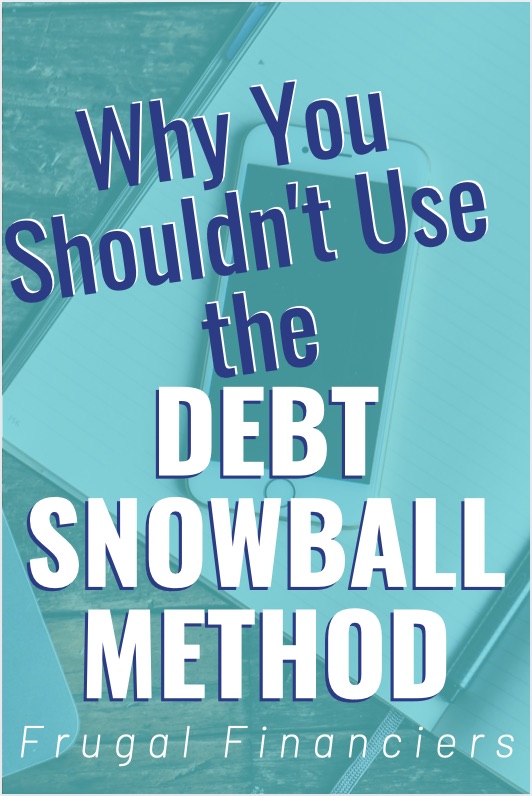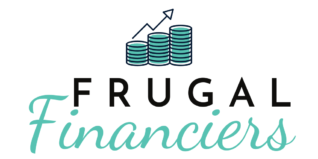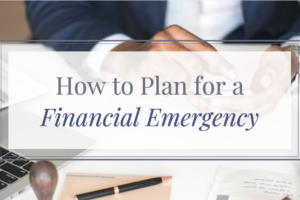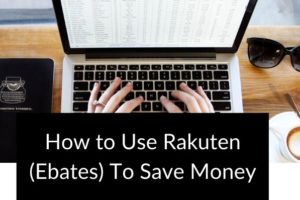If you’re on the journey to pay off debt you may have heard of the debt snowball method.
It is a way of paying off debt popularized by Dave Ramsey.
There are a lot of personal finance tips that Dave Ramsey and us agree on.
However, there are also a bunch of ways of handling your personal finances that we think Dave Ramsey gets wrong.
One of those aspects that we don’t agree on is using the debt snowball method to payoff your debt.
What is the Debt Snowball Method?
The debt snowball method is a way to pay off debt that focuses on the psychological and behavior aspect of debt before the financial aspect of debt.
The order in which you pay off debt is based on the size of individual debts, rather than the other financial characteristics of the debt.
If you are making more than the minimum payments on your debt each month, that extra amount is the snowball.
When you pay off a debt, you no longer have a minimum payment.
In the same way you build a snowball, you roll that minimum payment amount into the extra money to pay off debt.
How Does the Debt Snowball Method Work?
The debt snowball method is pretty simple to use for paying off your debt.
Create a list of all of your non-mortgage debts and their amounts.
Then create an order for paying off each of the debts from the smallest amount to largest amount after paying the minimum payments on each.
Since you are paying off the smallest debts first, you should quickly feel some gratification and sense of accomplishment.
This sense of accomplishment will keep you motivated to pay off the next largest debt so that you can feel th
The idea is that it feels really good to pay off an individual debt.
If you can create that good feeling early and often, you’ll build momentum reach your goal of paying off all of your debt.
There are some details to using the debt snowball method.
You need to figure out how much money you can put towards your debt each month.
This can be done by creating a budget.
You also need to figure out the minimum payments for each of your debts.
First, pay all the minimums on your different forms of debt.
Next, use the remainder of the monthly debt pay off amount and put it towards the debt with the smallest amount.
Do this each month until you pay off all of your debts!
Debt Snowball Method Example
As an example, you have three debts:
- Credit Card Debt of $2,300 and $50 minimum payment
- Car Loan of $5,400 and $225 minimum payment
- Student Loan Debt of $12,000 and $175 minimum payment
You have $600 to pay towards debt each month.
The minimum payments total $450 so you have $150 each month extra to use on paying off debt. The $150 is your snowball.
Using the debt snowball method, you would pay down the credit card debt using the extra $150.
What about when you pay off the credit card debt?
Once you pay off the credit card debt you would now have an extra $50 or $200 total extra each month to pay off debt. Your snowball is a little bit bigger.
You would put the $200 towards the next biggest debt, the car loan.
Does the Debt Snowball Method Work?
The debt snowball method does work for paying off your debt.
There are plenty of success stories across the internet about people using the method and becoming
There is even research that shows it’s the most effective way to pay off debt.
But, will it work for you?
If you have trouble staying motivated or have a lot of small debts, this could be a good way for you to reach financial freedom from debt.
However, the method may cost you extra money.
Is the Debt Snowball Method the Best?
Obviously, we don’t believe that paying off your debt using the snowball way is the best method.
While it is a good way of keeping you motivated to pay off your debt, it can result in you wasting money.
We hate wasting money.
The debt snowball approach ignores one of the biggest aspects of debt.
Interest.
Without interest, debt is just money you’ve spent that you have to pay back.
Like when your friend pays for lunch and you send back money through an app like Venmo or the cash app. Until you send the money, you are in debt to your friend.
Unfortunately, debt and interest almost always go together.
You have to pay interest to borrow money to buy something.
Your friend or someone else usually isn’t there to lend you interest-free money.
Is it Better to Pay Off Small Debts First?
Now, you may be asking:
But, wait! Isn’t staying motivated to actually pay off your debt more important than saving money on interest?
Our responses is: Why not both?
Why should you sacrifice money that you could use to pay off your debt faster to stay motivated to pay off debt?
Don’t get us wrong, staying motivated while paying off debt is important.
But, paying off your smaller debts first just to stay motivated isn’t better than paying off your debts with the highest interest rates.
Paying off debts from smallest to largest is just one of the ways of staying motivated.
Even Dave Ramsey discusses other ways to stay motivated while paying off debt.
Paying off debt requires you to stay motivated and concentrated and focused.
But, there are multiple forms of motivation to accomplish a goal and people respond to different forms of motivation in different ways.
So, why not figure out how to stay motivated while paying off debt but also spend the least amount of money doing it?
Why You Shouldn’t Use the Debt Snowball Method
We love that the debt snowball method
We’re all about accomplishing financial goals and it usually requires changing your thinking and habits to accomplish them.
Even personal finance tools like a budget are more about getting you to think about your spending instead of the numbers on a worksheet or spreadsheet.
But, at the end of the day, finance is about making the best financial decisions.
There are other ways to stay motivated while you’re paying off debt.
And, the snowball method is not the most cost-effective way of paying off debt.
Those are the two main reasons why you shouldn’t use the debt snowball method to pay off your debt.
There are smaller reasons but they fall into one of those two main reasons.
For example, some loans have tax advantages like student loans that can reduce the total cost of the loan.
You probably want to consider this in the cost of each loan when you’re figuring out how to pay off debt.
How to Pay Off Debt
So, if you’re not going to use the snowball method, what should you do instead?
The short answer is to pay off your debt from highest interest rate to lowest interest rate.
Sometimes this way to pay off debt is referred to as the debt avalanche method.
We’re not exactly sure why it
Whatever the reason, we think that name sucks and prefer to call it the best method for paying off debt.
You could also call it
So, what should you do to start using this method?
A good first step is to create a list of all your debts.
You want to include the balance of the loans, the interest rates, the monthly minimum payment and any unique aspects.
Unique aspects could include tax advantages like with student loans and mortgages or delayed interest rates common with credit cards and car loans.
You want to pay the minimum payments on all of your forms of debt and then put all the extra money towards the loan with the highest interest rate.
Those unique aspects may cause situations where you have to calculate the true cost of a loan but generally you can follow the first rule.
For more on the order of paying off debt, check out our posts:
When you pay off your debts with the highest interest rates first, you’ll spend the least money paying off debt and you’ll be using the fastest way to pay off debt.
As long as you stay motivated and continue to pay down your debt.
The method doesn’t really include a built-in way to stay motivated while paying off your debt.
That means that you’ll have to think about the best ways for you to stay motivated and pay off your debt.
How to Stay Motivated While Paying Off Debt
It can be tough to stay motivated and pay off your debt.
Especially, if you’re a spender.
If you’ve been going further into credit card debt it means that you not only have to be disciplined with paying off debt but you also have to change your spending habits.
If you have student loans, a mortgage, or a car loan that you want to pay off, you might not have to spend much time focusing on your spending habits.
Still, it can be hard to pay off your debt and feel good about it.
It feels great to save money because you still have the money.
But, paying off debt doesn’t always have that same feeling.
Sure, you don’t have the debt any longer but you also don’t have the money any longer too.
So, you may feel a sense of freedom but you could also feel like nothing changed.
We often felt like that as we paid off $100,000 of debt because it felt like we were just throwing our money away instead of building wealth.
It’s totally normal to feel like that and it’s why its good to find ways of staying motivated.
Our favorite way to stay motivated was watching our interest payments go down.
Interest is the amount you pay each month for using debt.
Check out our post on how much your debt costs you each day for more information.
Again, there are a few things we hate more than wasting money.
To us, paying interest always feels like wasting money.
To stay motivated, we calculated how much interest we paid each month.
And, each month that amount went down until we paid off our debt.
Each month was a win because we paid less interest than the last month.
A Few Other Ways to Stay Motivated to Pay Off Debt
If you hate wasting money, you should definitely try our motivation method of calculating your interest cost each month.
Usually, the account statement will say how much of the balance you paid off and how much in interest you paid each month.
Each month that amount is going to get smaller, meaning that your debt is getting smaller.
It’s also good motivation because you’ll be pissed that you’re spending money on interest.
But, there are also other ways to stay motivated.
Record Your Debt Payoff Journey
A great way to stay motivated is to record your journey.
There are all kinds of forms to keep track of your journey to pay off debt.
You could record a monthly video about paying off debt.
Or, you could write in a journal about your path towards becoming debt-free.
Another option is posting your journey on a social media platform or within a group of people who are on the same journey.
This method helps to keep you motivated because you keep the process of paying off debt in your head.
If you journal about how much debt you’ve paid off over the last month, you’re continuously thinking about paying off debt.
Use Why You Want to Pay Off Debt as Motivation
Why do you want to pay off your debt?
Create a list of all of the reasons that inspired you to achieve debt freedom.
Spend some time with this list and think about your number one reason for becoming debt-free.
Ask yourself what you plan to do with the extra money when you pay off your debt.
Maybe even plan to reward yourself once you reach this financial goal.
You can also come back to the list and review it and remind yourself why you’re paying off debt instead of spending that money on the
We even put up big signs of the reasons why we wanted to reach debt freedom to remind us every day why we were paying off debt.
Create a Visual Representation of Your Debt Payoff Journey
Thinking back to the difference between saving money and paying off debt, you may want to create a visual representation of your journey to pay off debt.
When you save money, you can see the amount in a savings or investment account.
But, when you pay off debt there isn’t anything that you can see that sparks a sense of accomplishment.
When you get to zero on a loan or credit card, that should make you feel accomplished and motivated.
But, what do you do in the meantime?
Why not create a block chart that you fill in for each $100 of debt paid off?
Or, a big arrow pointing downward that you fill in with your favorite color as you get closer to $0 of debt.
Turn Paying Off Debt into a Challenge
There’s nothing that gets us more motivated than a challenge.
So, why not turn paying off debt into a challenge.
Set mini challenges for how much debt you’re going to pay off each month.
Maybe create a challenge where you pay off increasing amounts of debt for 3 months in a row.
You could even challenge yourself in other areas to pay off debt faster.
For example, say you spend $150 each month on dining out.
Challenge yourself to not dine out and put all of that money towards your debt for the month.
These challenges will help you pay off debt faster and keep you thinking about your debt.
Final Thoughts
While the debt snowball method is a great way to stay motivated while paying off debt and has helped many people become debt-free, it will likely cost you extra money to use this method.
We just don’t think that the motivation is worth the extra money given that there are other ways to stay motivated while paying off your debt.
Instead, you should focus on paying off your debt with the highest interest rate first and use one or more of the many other ways to stay motivated.
Paying off debt is a journey and there are going to be moments when it’s really hard.
You usually have to sacrifice something to pay off your debt.
That’s why we think you should stay motivated to pay off your debt but also do it as fast as possible.





Leave a Reply
Your email is safe with us.
You must be logged in to post a comment.